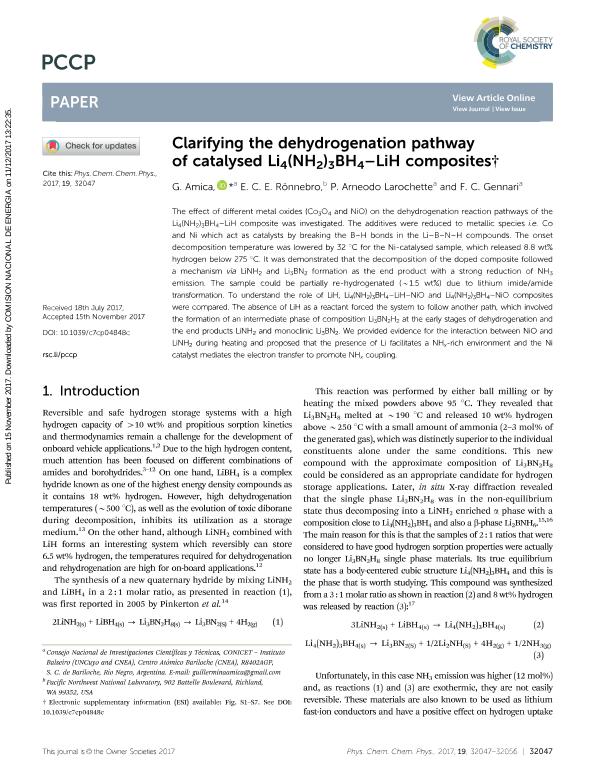Artículo
Clarifying the dehydrogenation pathway of catalysed Li4(NH2)3BH4-LiH composite
Amica, Guillermina ; Rönnebro, E. C. E.; Arneodo Larochette, Pierre Paul
; Rönnebro, E. C. E.; Arneodo Larochette, Pierre Paul ; Gennari, Fabiana Cristina
; Gennari, Fabiana Cristina
 ; Rönnebro, E. C. E.; Arneodo Larochette, Pierre Paul
; Rönnebro, E. C. E.; Arneodo Larochette, Pierre Paul ; Gennari, Fabiana Cristina
; Gennari, Fabiana Cristina
Fecha de publicación:
15/12/2017
Editorial:
Royal Society of Chemistry
Revista:
Physical Chemistry Chemical Physics
ISSN:
1463-9076
Idioma:
Inglés
Tipo de recurso:
Artículo publicado
Clasificación temática:
Resumen
The effect of different metal oxides (Co3O4 and NiO) on the dehydrogenation reactions pathways of the Li4(NH2)3BH4-LiH composite was investigated. The additives were reduced to metallic species i.e. Co and Ni which act as catalysts by breaking the B-H bonds in the Li-B-N-H compounds. The onset decomposition temperature was lowered by 32 °C for the Ni-catalysed sample, which released 8.8 wt% hydrogen below 275°C. It was demonstrated that the decomposition of the doped composite followed a mechanism via LiNH2 and Li3BN2 formation as the end product with a strong reduction of NH3 emission. The sample could be partially re-hydrogenated (~1.5 wt%) due to the lithium imide/amide transformation. To understand the LiH role, the Li4(NH2)3BH4-LiH-NiO and the Li4(NH2)3BH4-NiO composites were compared. The absence of LiH as a reactant forced the system to follow another path, which involved the formation of an intermediate phase of composition Li3BN2H2 at the early stages of dehydrogenation and the end products LiNH2 and monoclinic Li3BN2. We showed evidence for the interaction between NiO and LiNH2 during heating and we propose that the presence of Li facilitates a NHx-rich environment and the Ni catalyst mediates the electron transfer to promote NHx coupling.
Palabras clave:
Hydrogen Storage
,
Lithium
,
Ni
Archivos asociados
Licencia
Identificadores
Colecciones
Articulos(CCT - PATAGONIA NORTE)
Articulos de CTRO.CIENTIFICO TECNOL.CONICET - PATAGONIA NORTE
Articulos de CTRO.CIENTIFICO TECNOL.CONICET - PATAGONIA NORTE
Citación
Amica, Guillermina; Rönnebro, E. C. E.; Arneodo Larochette, Pierre Paul; Gennari, Fabiana Cristina; Clarifying the dehydrogenation pathway of catalysed Li4(NH2)3BH4-LiH composite; Royal Society of Chemistry; Physical Chemistry Chemical Physics; 19; 15-12-2017; 32047-32056
Compartir
Altmétricas



